The evolution of technology continues to play a vital role in our daily lives including within the world of sports cards. As sports cards have evolved over the years, sports cards sales are at all-time highs. Sports card collectors, sports card investors, and sports cards flippers continue to see record sales prices and buzz around the trading card industry. Learning how to pre-grade sports cards can help you save money and increase your profits.
While sports cards sales are high one aspect of that is the increased popularity of sports card grading and the impact high graded sports card increase the sales value. Understanding the costs associated with grading, and the chance of the increased sales price, the need for collectors to understand how to pre-grade sports cards is key. There are many great third-party sports cards grading companies on the market, receiving a low grade such as a 7-8.5 can be disheartening. This makes it important for sports card collectors, sports card investors, and individuals looking to flip sports cards for a profit to learn how to pre-grade their own sports cards to help save money.
As you continue to read on, we will examine how to pre-grade sports cards, what types of sports grading tools can help with this process, and even a few tips to help you determine which sports cards you should have graded by a third-party sports card grading company. Also take a look at our sports card grading guide and hot sports cards right now to help you determine which sports cards to have graded.
How to Pre-Grade Sports Cards
What is Sports Card Grading?
Sports card grading is the process in which any individual sports card is delivered a numerical graded based on a sports card grading scale. The standard grading scale used by the top sports card grading companies such as BGS, PSA, CSG, and SGC is a 1-10 scale. The sports card collector secures the card or cards, ships them to the third-party grader, a grade is delivered, the card is encapsulated, then the card or cards are shipped back.
Why have your sports card graded?
There are a few reasons why you have your sports cards graded by a third-party grading company. The first of those reasons and the main reason is the impact high graded sports cards have on the value of that sports card. Having your sports card graded and receiving a 9, 9.5, and 10 by a company such as BGS or PSA will drive the value of the card up. Graded sports cards sell for higher values then ungraded sports cards.
A second reason to have your sports cards graded is the protection an encapsulated case delivers to the sports cards ensuring your investment is protected for the long haul.
Why Pre-Grade Sports Cards before you have them graded by Third-Party Grading Services?
If you are new to the hobby, you are probably wondering why you should take the time to pre-grade your sports cards when you can just send them to one of the big sports cards grading companies. The main reason is the opportunity to see the condition of your card as the grading companies would and determine whether or not to spend the money to have it graded. Third-party sports card grading can get expensive while receiving a low-graded sports card in return will lower the overall value of the card.
In addition, taking the time to learn how to pre-grade sports cards effectively will reduce the future disappointment when a low grade is received when you were expecting higher. In the end pre-grading, your sports cards will not only save you money, but also increase your overall profits.
Research the Grading Standards of Top Third-Party Grading Services to help you pre-grade sports cards
Before you start to pre-grade your sports cards take the time to learn the grading standards used by companies such as PSA, BGS, SGC, and CSG. Each of these companies have their own set of grading standards that are available for you to help you learn the hobby of grading sports cards. You can also read those standards by clicking the links below:
BGS Grading Standards
One of the top sports card grading companies in the industry, Beckett Grading Services (BGS) grades sports cards on a 1-10 grading scale. In addition, BGS delivers grades for four individual subgrades to include centering, corners, edges, and the surface. Each individual grade impacts the overall grade of the sports cards.
Here is BGS Grading Standards.
SGC Grading Standards
Over the years (SGC) has evolved over the years while evolving to the third-party grading company they are today. SGC grading standards operate on a 1-10 grading scale with ½ point designations. SGC grading focuses on centering, crisp focus images, sharp corners, no stains, no issues with the gloss, no refractor lines, and no wear to the surface.
Here is SGC Grading Standards.
PSA Grading Standards
Like most third-party sports cards grading companies Professional Sports Authenticator (PSA) grading standards work around a 1-10 grading scale while looking various qualifiers to impact the cards. These qualifiers include marks, miscuts, off-centered printing, print defects, out of focus images, and staining.
Here is PSA Grading Standards.
CSG Grading Standards
The last of the major grading card companies within the industry is Certified Sports Guaranty (CSG). CSG uses a standard 1-10 grading scale with a 10 Perfect, and a 10 Gem Mint. CSG uses a 10x magnification process to inspect the surface, edges, centers and corners.
Here is CSG Grading Standards.
Grading Tools Required to Help Pre-Grade Sports Cards
Before getting started pre-grading your sports cards there is a few key tools to help you along the way. These tools allow sports card collectors an opportunity to inspect sports cards easier while magnifying any imperfections that would impact the grading of the sports card. Here are some tools to help you get started today.
Jewelers Loupe Magnifier – #2 Pre-grade Sports Cards Tool
One of the main tools every sports collector should invest in is a Jewelers Loupe Magnifier. Jewelers use these tools to inspect jewels at high magnification levels including up to 40x. Using this tool can allow sports card owners a chance to inspect the sports cards up close to see any imperfections including flaws within the surface, the corners, and any print flaws.
30x Jewelers Loupe Magnifier
10x Illuminated Jewelers Loupe
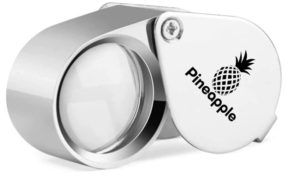
Standard 6” Ruler
One of the most basic tool every sports card collector, sports card investor, and sports card flipper should have within their tool collection is a standard 6” ruler. 6” standard rulers allow you to measure each card height and width. Sports cards vary and size but having a ruler to measure to ensure the card has not been modified, and or trimmed will ensure the card grades properly. Use this guide to learn more about card sizes.
Standard 6” Ruler
![]()
Microfiber Cloth
A microfiber cloth can be a valuable tool especially with today’s trading cards that feature high gloss surfaces. Using a microfiber cloth can allow you to wipe away any fingerprints or flaws that appear on the surface while avoiding damage to the card if used properly.
Microfiber Cloth
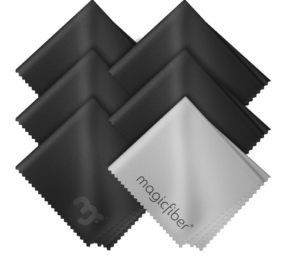
Blacklight/Blacklight Flashlight
Another cheap tool to use when pre-grading your sports card collection in a blacklight flashlight that can be used to observe the surface of the sports cards. In addition, using a black light properly can also help in determining if the sports card is a reprint or has been altered.
21 LED LED Mini Black Light Flashlight
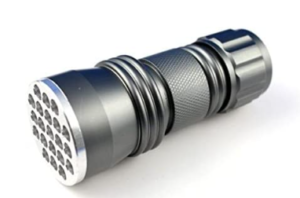
51 LED Ultraviolet Blacklight Flashlight
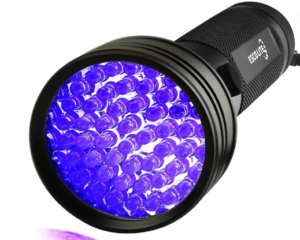
Omnigrid Rulers – Pre-grade Sports Cards Tools
One interesting tool that can be beneficial to your pre-grading sports cards needs is a omnigrid ruler. While omnigrid rulers are typically used for quilting, patchwork and types of cuts needed to make strips. However, this tool can be used to see whether there are flaws in the shape of the card, and the corners of the card.
Omnigrid 6×6 Ruler

Omnigrid 6×12 Ruler
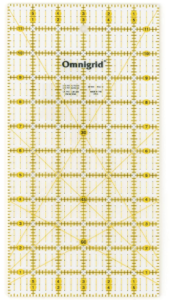
The Center Tool Card Grading Tool – #1 Pre-grade Sports Cards Tool
While omnigrid tools are useful, adding The Center Tool designed for sports card grading to your tool collection is a must. The tool is used to help determine whether the sports cards are centered and delivers you a centering percentage. Once you master using this tool, it makes it easier for you to know real quick whether a card is worth grading or adding to your collection and/or selling it raw.
The Center Tool – Card Grade Centering Tool
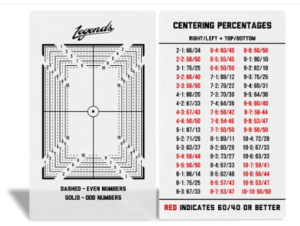
Card Saver Semi-Rigid Card Holders
Semi-card rigid card holders are not really a tool used to help grading but it can be used to allow you to send your sports cards in for grading when you have determined which cards to have graded. In addition, semi-rigid card holders can help protect your cards from damage.
Ultra Pro Semi-Rigid ½ Lip Sleeves
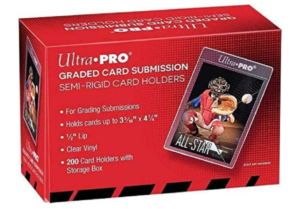
Saftgard Supplies Semi-Rigid Card Sleeve Card Holders
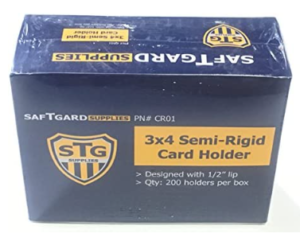
How to pre-grade sports cards?
Learning how to pre-grade your sport cards can be difficult at first and honestly can be difficult throughout the process especially after receiving a card back with a grade you weren’t expecting. However, taking the time to learn how to inspect, prep, and package your sports cards before sending them off to third-party sports card grading companies can help. With sports card grading fees rising, ensuring you receive a high grade is a must.
Step 1 – Take Photos & Scan Cards (Key to Pre-grade Sports Cards)
First layout the card on a flat surface with adequate lighting and a good background. Use a digital camera or your smart phone and take photos of the cards and then flip the card over and repeat the process. In addition, you can invest in a high-quality scanner to scan both front and rear of the sports cards. Once images are obtained, you can examine the cards to see if you can see any flaws that may be present.
Step 2 – Use Centering Grading Tool
Second use the centering grading tool with the card positioned on a flat surface. Place the centering grading tool below the clear window on the tool. Use the tool to determine the percentage of the centering of the sports cards.
Step 3 – Continue Examining Sports Cards
Third inspect the sports cards using your magnifying loupe, ruler, and omnigrid to help you continue to inspect the sports cards up close for additional flaws. Once using these tools, decide on which cards are worth grading and which ones are not.
Step 4 – Record Pre-Grades, Ship For Grading, Wait for Results
Fourth record your grading predictions for each card you elect to send out for grading, ensure photos are retained. Ship sports cards to the third-party grading company of your choice. Wait for sports cards to return. Once return, compare your grades to the received grades, and keep these records either on paper or within an excel spreadsheet. Before sending in bulk, ensure you complete this task multiple times to see how your pre-grade compares to the ones received.
Step 5 – Repeat, Repeat and Repeat
Once you show consistency and accuracy in your pre-grades, you can start to ship cards in bulk while repeating these steps. Remember, landing a bad grade at first might cost you money but it will help you get better and ensure you master it before sending 50-100 cards for a bulk submission.
Tips & Tricks to Help Pre-Grade Sports Cards
As far as any tips or tricks with helping you pre-grade sports card one of the best tips is to take time to learn the hobby, visit local hobby shops, and local sports card stores. Use these to help build up your knowledge. In addition, take the time to go to local sports card shows and National Sports Card Shows such as the National Sports Convention each year. Have your cards graded on site while asking any questions that might help you along the way.
Another tip is to expect to receive grades lower than what you have set on your pre-graded sports cards. If it was easy everyone would be able to get graded 10’s and nothing else. Sports card grading is a key component to increasing your profits and increasing the values of your sports card investment.
Lastly have fun, take time to master the art of pre-grading your sports cards, and continue to enjoy the sports card hobby.
[ Grade your cards with AI in real-time >> https://bit.ly/3SMSfxV ]
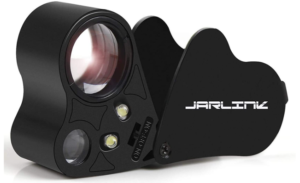
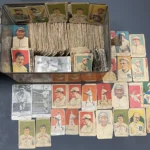



1 Comment